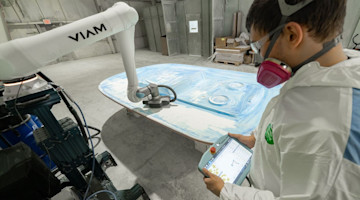Collaborative robots – or cobots – go back to the mid-1990s, but their commercial availability became more pronounced in the mid-2000s. During the second half of that decade, the availability of these devices, which are ostensibly meant to work closely with human workers, became widespread, and the growth of the number of devices as well as their capacities and architectures increased commensurately.
There are plenty of applications where cobots and humans work in proximity and harmony. In an industrial setting, cobots generally work either separately from human workers within a given space or sequentially with the worker in the space. There are strict safety protocols for cobots (notably ISO/TS 15066:2016) to protect human workers in these interactions. The cobots are fitted with a sensor suite and are either lightweight or even padded to minimize any harm that could result from an unintended intersection between the worker and the cobot.
If you consider the history of industrial robots, you’ll recognize that their initial purpose was to do the work that was less desirable – working in diecasting operations or feeding stamping presses, for example. It is almost inconceivable that applications like these would revert back to manual operation.
With time, robots have become far more capable, such as performing electronics assembly at a rate and with accuracy that couldn’t otherwise be done; advances in servos, sensors, and end-effectors have added dexterity to their abilities.
But there are still numerous tasks that human workers do best. A key concept behind the cobot is to work in close proximity to humans to help with those tasks.
We’ve found, however, that in some instances, there is a gap between the conceivable and the actual, and it is important to be aware of this when considering the implementation of the technology.
This tech is good – when done right. Implementation design can make all the difference.
Design for Collaboration
It is important to consider “collaborative workspaces” rather than just the robot arms.
In this scenario, a work area is set up with an array of sensors. The robot – be it a cobot or a more traditional six-axis arm – is within the matrix created by the sensors. The robot can operate at optimal speeds until a human enters the area; at which point, the robot slows down in order to provide the necessary levels of safety. The collaborative workspace is also configured such that it accommodates things like heavy parts and sharp end-effectors.
There is another benefit to this setup that goes beyond the tasks being performed by the robot and the worker.
The sensors can collect data about the operation. Consequently, there can be improvements made to the process. Or it could be that there are some quality issues that the sensors discern, which can then be used to quarantine the parts. The operation can be adjusted so those problems don’t occur again.
Realize that sensors are getting not only more powerful so that they can actually perform analysis at the edge, but they are quite inexpensive, especially in the context of the information that they can provide for overall process improvement.
Design the work environment for collaborative work; don’t just think of the task as getting a cobot and everything will go just fine.
The AMR Advantage
All of that said, one of the types of collaborative automation devices that is showing real advantages for many manufacturers is the AMR, or autonomous mobile robot. This should not be mistaken for an AGV, or automated guided vehicle. The AGV depends on things like wires or tape in or on the floor that the vehicle follows from point A to B. If there is a need to go from point A to C, then there must be something physical done (e.g., put down more tape).
An AMR, however, uses sensors and computing power (in some cases AI and machine learning) in order to navigate safely through a facility. It is capable of moving around an obstacle, whether it is a piece of equipment that isn’t supposed to be where it is or a person who happens to have stopped in its path (an AGV will stop until whatever is moved). What’s more, should there be a change of route from point A to C, this is more likely to be handled by a few lines of code, not a few yards of tape or wire.
The AMR provides a great advantage when there are adjustments in the workflow for a facility, as this can be effected quickly compared to the AGV alternative.
Without question, going forward, there will be an increase in the number of collaborative operations with cobots and AMRs. However, in both cases, to get the greatest advantage, good workspace design – design for collaboration – is absolutely essential to gather as much information and research as possible from builders, integrators, manufacturers, and those working within the operations. After all, it has been my experience that when multi-disciplinary teams collaborate, optimization is achieved.
If you have any questions about this information, please contact Andra at akeay@AMTonline.org.





